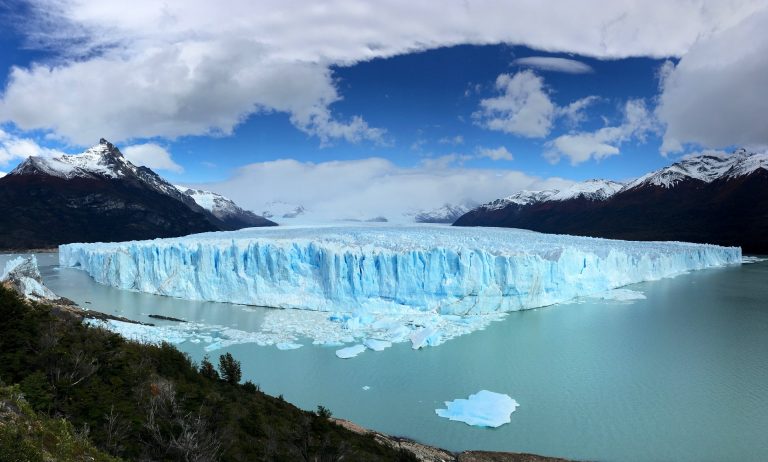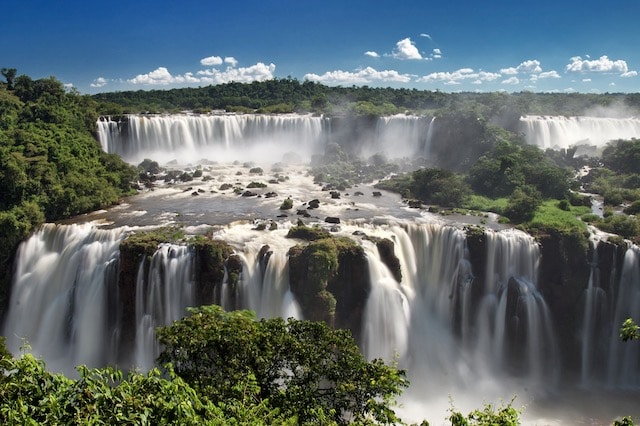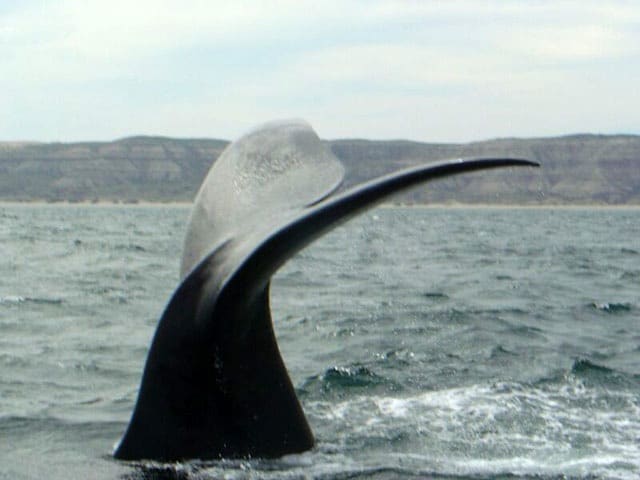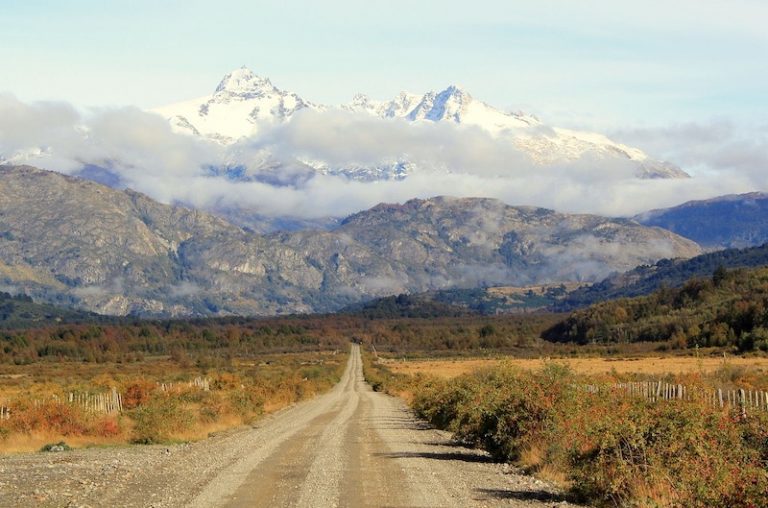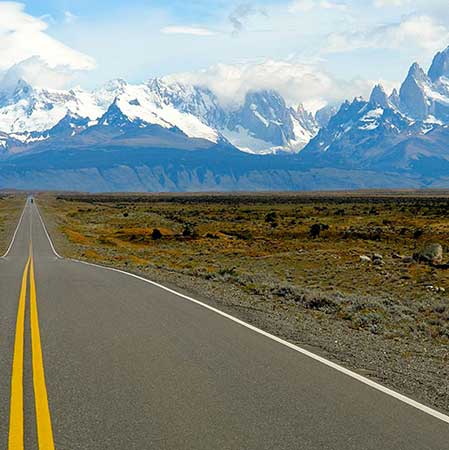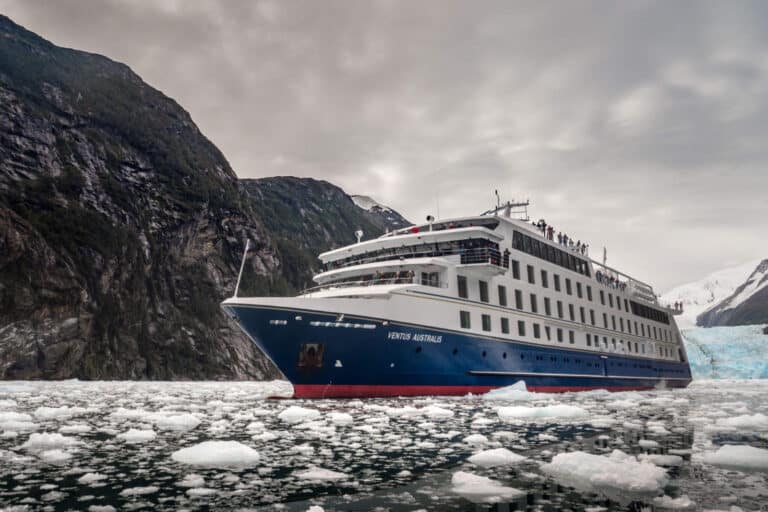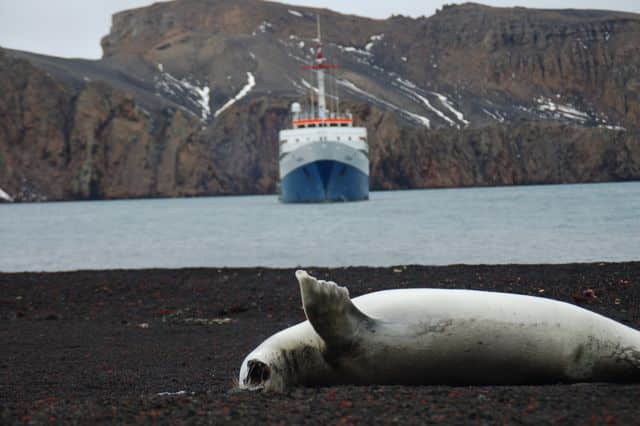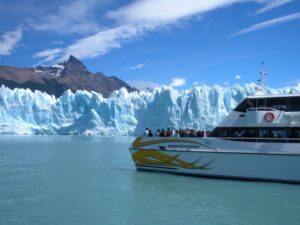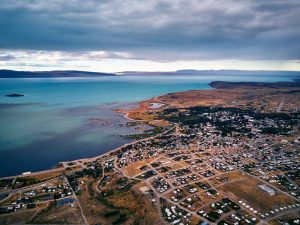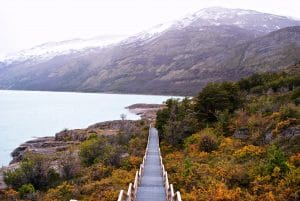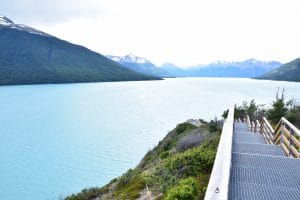The Upsala Glacier is, together with the Perito Moreno Glacier , the most visited glacier in the region. The Upsala Glacier owes its name to the Swedish city whose University sponsored in 1908 the first glaciological study of the region whose objectives included, precisely, this glacier.
It consists of two terminal tongues, each approximately 4 km wide. (Only the western tongue can be observed from the lake excursion).
Its surface area is 870 km and its length is 60 km, which makes it the longest of the Continental Ice Field and therefore of South America. The height of its front is approximately 60 meters above lake level.
Its upper part is so flat that it was chosen by the Antarctic Command of the Argentine Army as a training area for its troops destined to the White Continent (Antarctica), and on one occasion a DC-3 aircraft was landed on it, today on display at the Aeronautical Museum of the Aeroparque in Buenos Aires.
Its front speed, measured in November 1990 over a 4-day interval, was 3.6 meters per day.

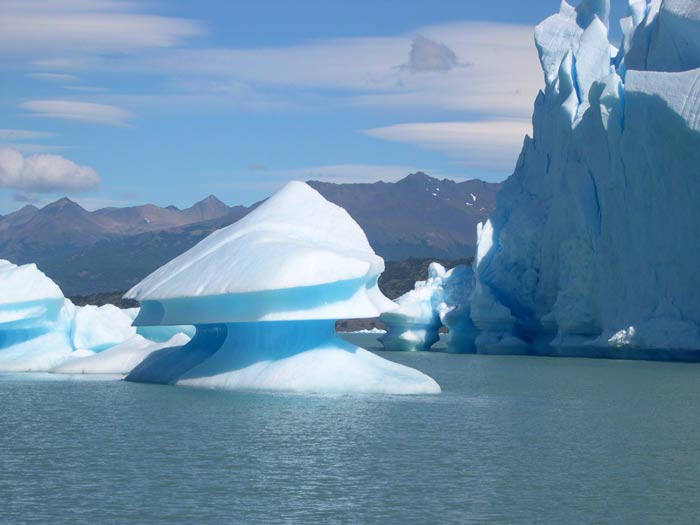
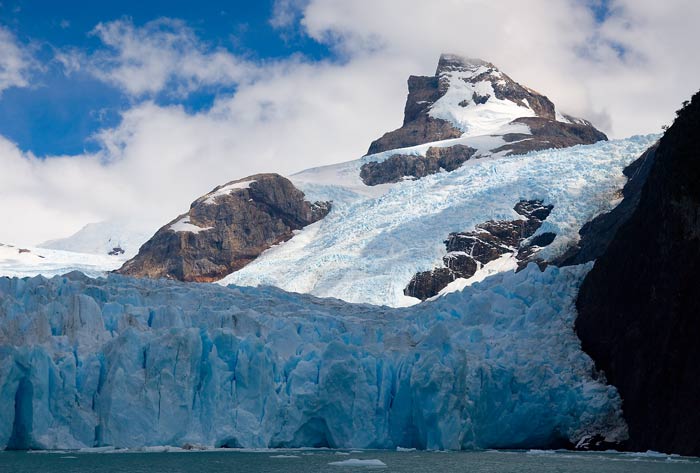
Contrary to the Perito Moreno Glacier, the Upsala Glacier is characterized by its stability.
One of the most beautiful spectacles that the Upsala Glacier offers, is e1 of its large drifting icebergs, which detached from the front of the glacier, then sail pushed by the wind along the North Arm and then Lake Argentino, to anchor at the eastern end of it, where wind, sun and rain eventually melting them.
Often overshadowed by the more popular Perito Moreno Glacier, the Upsala Glacier certainly deserves some time in the spotlight. The Upsala Glacier is located in Los Glaciares National Park in the Argentinean portion of Patagonia. With an extension of more than 870 km², the glacier is actually the largest of its kind in South America.
The jagged icy peaks of the Upsala Glacier, which can be seen from quite a distance, are just a taste of what is to come. As travelers approach the glacier face they are likely to feel as if they have been transported to a different world. The eerie silence, broken only by the rippling of the water beneath the boat, only enhances the experience. Definitely a show you will never forget.
El glaciar Upsala se encuentra en Argentina, en el Campo de Hielo Patagónico Sur. Este enorme cuerpo de hielo cubre más de 12.000 kilómetros cuadrados, lo que lo convierte en el tercer campo de hielo más grande del mundo.
El glaciar upsala está en constante movimiento, trabajando para esculpir los profundos valles y montañas de esta región.
Su impresionante tamaño lo ha convertido en un destino popular para científicos y aventureros por igual, que acuden a su terreno helado para investigar y explorar.
Sin embargo, lo que hace que el glaciar Upsala sea especialmente notable es su rápido ritmo de retroceso. Debido al calentamiento global, esta enorme masa de hielo ha perdido más de 7 kilómetros de longitud desde la década de 1970.
Sirve de sombrío recordatorio de los alarmantes efectos del cambio climático en las maravillas naturales de nuestro planeta. Mientras seguimos vigilando y estudiando la progresión del glaciar Upsala, sigue siendo un lugar importante para comprender el impacto de la actividad humana en nuestro medio ambiente.
Si quieres visitar el glaciar Upsala en Argentina, la mejor opción es hacer una excursión en barco desde la ciudad de El Calafate. Sólo se puede llegar al glaciar navegando por el lago Argentino.
Varias empresas ofrecen excursiones para explorar los impresionantes paisajes del glaciar. Es importante tener en cuenta que los visitantes deben seguir siempre las directrices de seguridad y contratar a un guía si se aventuran en el propio glaciar. Para vivir una experiencia única en la vida, el glaciar Upsala merece la pena.
Location of the Upsala Glacier
The Upsala Glacier is difficult to access. In fact, the only way to approach the glacier is to take a boat across Lago Argentino. However, there are also options by land from where you can appreciate the Upsala Glacier in the distance.
Upsala Glacier Excursions
Boat ride
Access the Upsala Glacier inside the Patagonian Ice Field from a boat ride.
The most common way to visit the Upsala Glacier is by boat. There was a time when the Upsala Glacier was inaccessible due to the number of icebergs in the water. These icebergs blocked the way for ships making travel impossible.
If you decide to visit the Upsala by boat you will have to take the boat at the port of Punta Bandera on Lake Argentino and then the boat will sail to the Upsala arm of the lake.
Kayak tours
An excursion to the Upsala Glacier by kayak is the most incredible way to experience this glacier and a unique viewing experience. Depart in double kayaks and head to Lago Argentino to see the Upsala Glacier.
Floating along the milky waters so close will surely surprise you. At certain points, they will even be close enough to touch the ice.
4×4 excursions
If you want to keep your feet on solid ground, you have another way to experience the Upsala Glacier. This comes in the form of a 4×4 excursion to Estancia Cristina.
During this excursion, you will be driven to the Upsala observation point from where you will have spectacular views of the glacier. Although the views from the lookout are the best, there is also much beauty to admire on the trip. In general, it is a very aesthetic way to visit the Upsala Glacier.
7 Fascinating facts about Upsala
Often overshadowed by the impressive Perito Moreno Glacier, also located in Argentina’s Los Glaciares National Park, the Upsala Glacier deserves greater recognition for its unique record-breaking features. Here are seven fascinating facts about this incredible glacier.
It is the largest in South America
The Upsala Glacier is the largest glacier in the entire South American continent, has an area of 870 km2, a length of 60 km and a height of 230 feet. (70m) high.
It is much larger than its more famous cousin, Perito Moreno, which only covers 97 square miles (250km²) in area and has a length of 19 miles (30km) and a height of 240 feet. (74m).
It is one of the several glaciers that feed Lake Argentino.
The milky blue waters of Lago Argentino and Lago Viedma are the result of the melting of the Upsala glacier that flows from the surrounding ice. The Perito Moreno, Mayo, Spegazzini, Agassiz, Onelli, Ameghino and Upsala glaciers feed these lakes.
It is responsible for the strange color of Lago Argentino.
All glacier-fed lakes tend to be characterized by a distinctive milky green hue. Lake Argentino is no exception and its color is the result of glaciation processes.
The glaciers that feed it produce “rock flour,” a white powder that forms when a glacier scrapes and erodes the ground below as it moves down a mountain. This powder is then taken to water and changes its color.
Upsala Glacier is named after a Swedish university
The first university to sponsor glaciological studies in Glacier National Park was Uppsala, a Swedish university located 44 miles (71 km) from the capital, Stockholm.
Upsala is receding at an alarming rate
NASA images have shown that since 2001, the position of the ice front (the snout or foot of the glacier) of Upsala has retreated 2 miles (3km). Unfortunately, this follows the trend in Patagonia due to global warming and, indeed, worldwide, where almost all glaciers have experienced substantial retreats in recent decades due to climate change.
And it is becoming increasingly difficult to access.
Known for the extensive ice breakup at its foot, the Upsala Glacier has actually been largely inaccessible since 2008, when a series of huge icebergs broke off from Lake Argentino, blocking the approach to the glacier.
Although boats still try to approach the Upsala, it is becoming increasingly difficult, as one must now zigzag between the icebergs dotting the water.
As a result, the foot of the glacier has not been seen in years. Instead, boat excursions that sail as close as possible to the Upsala Glacier have better views of the nearby Spegazzini Glacier.
My organised trips to Patagonia
In the carousel below you can see already assembled itineraries for inspiration, click on the one you are interested in and ask me for a quote.
Compact trip through the southernmost Argentinean Patagonia: Ushuaia and El Calafate
Enjoy the 3 most relevant ecosystems in Argentina: The End of the World, The Glaciers and the Iguazu Falls.
Trip to Patagonia Argentina in 7 days touring the most beautiful landscapes of Patagonia Argentina (Peninsula Valdés & El Calafate)
The Carretera Austral by rental car is probably one of the most spectacular routes in Patagonia, designed to be travelled with plenty of time in your rental car.
Tour along Route 40 in Patagonia, starting on Route 3 on the Atlantic coast and continuing along Route 40 until reaching the Andes Mountains and El Calafate.
The Australis Cruises are Expedition Cruises that sail through the Strait of Magellan and the Beagle Channel, exploring one of the most beautiful and unspoiled regions of the world such as Patagonia and Tierra del Fuego.
The Antarctic Cruise aboard the MV USHUAIA offers you an incredible introduction to the 'White Continent' at a reasonable price.



